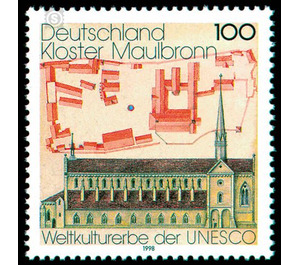Cultural and natural heritage of humanity - Germany / Federal Republic of Germany 1998 - 100 Pfennig
Theme: Architecture
| Country | Germany / Federal Republic of Germany |
| Issue Date | 1998 |
| Face Value | 100.00 |
| Color | brown |
| Perforation | K 13 3/4 |
| Printing Type | Multicolor offset printing |
| Stamp Type | Postage stamp |
| Item Type | Stamp |
| Chronological Issue Number | 1839 |
| Chronological Chapter | GER-BRD |
| SID | 58547 |
| In 29 Wishlists | |
In December 1993, the former Cistercian monastery Maulbronn was added to the list of World Heritage by UNESCO. When added to the UNESCO list, the Cistercian cultural landscape with its meticulously designed water system played an important role. The former abbey is one of the best preserved medieval monasteries north of the Alps, in which all styles, transitional styles and stages of development from early Romanesque to late Gothic architecture are represented. The tracery windows of the cloister alone seem to have captured the unlimited expressions of stonemasonry. The construction began in 1147, and as early as 1178, the church, a three-nave Romanesque basilica, was consecrated to Our Lady of Mary. Even today, the cloister is surrounded by the defensive wall and the towers, commercial buildings and dwellings that are mostly included, towed and raised above them. For more than 400 years, the monks of Maulbronn created a monastery whose impulses had an effect on medieval society and which were not only of a religious and cultural nature but also of a political nature. After the seizure by the duchy of Württemberg at the beginning of the 16th century and the effects of the Reformation, the monastic life ended in Maulbronn. In 1556, a Protestant monastery school (since 1806 Protestant seminary) was established, which is still represented in the former abbey. Famous poets and scientists, u.a. Johannes Kepler, Friedrich Hölderlin, Georg Herwegh, Friedrich Theodor Vischer or Hermann Hesse learned and taught in Maulbronn. (Text: Stadtarchiv Maulbronn)


